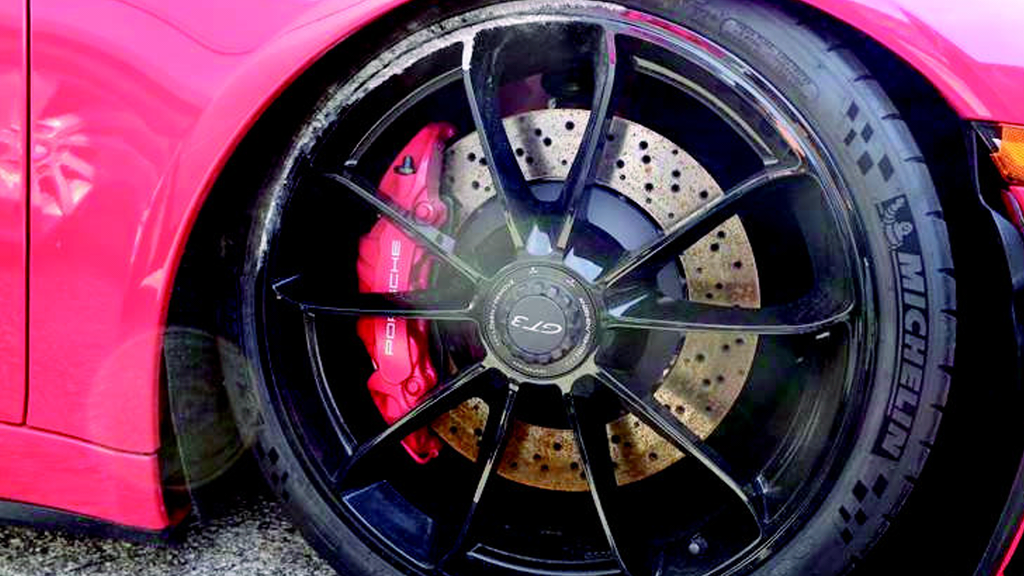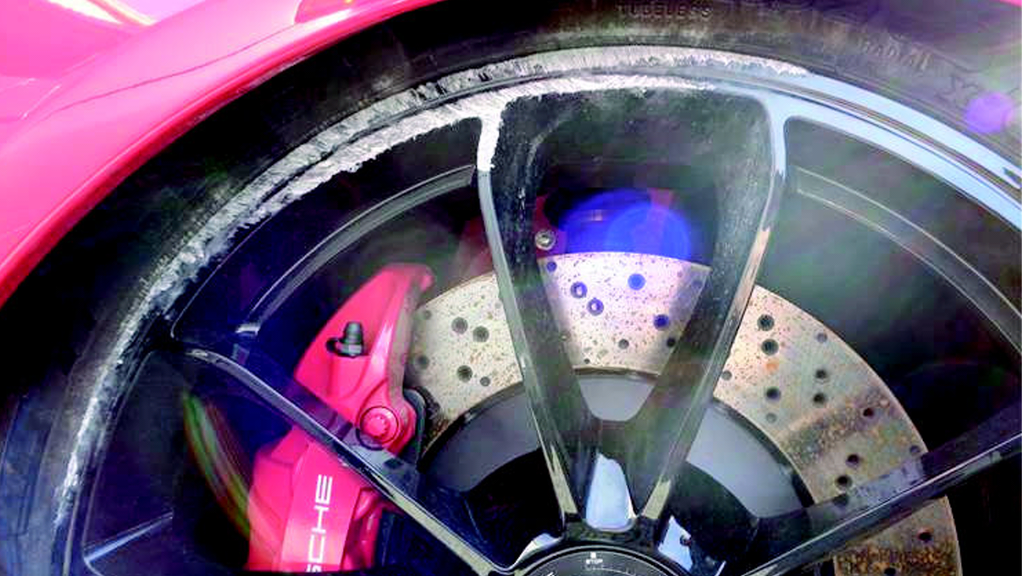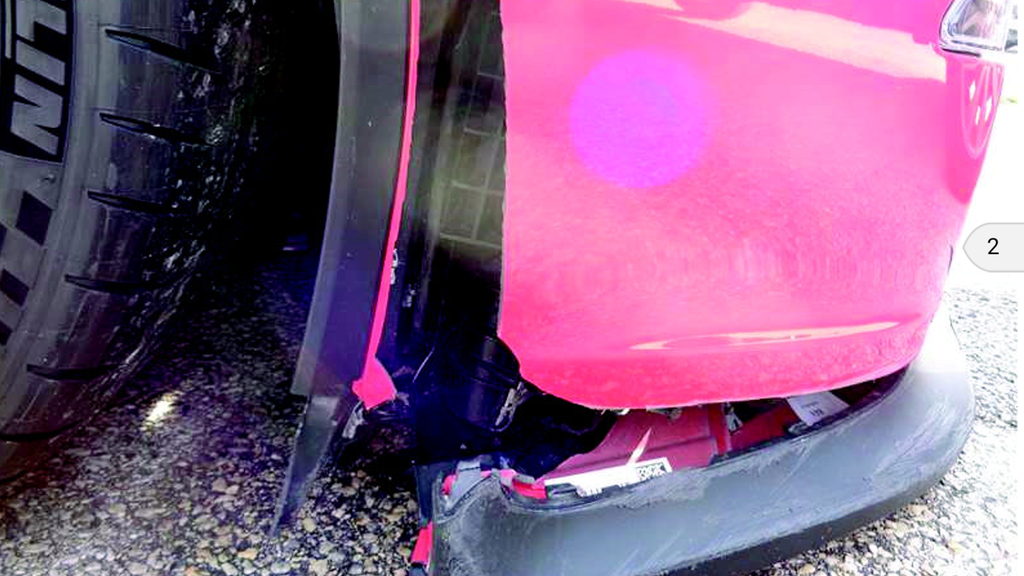strut tower failure
#47
Rennlist Member
#48
Rennlist Member
A pic of one of these failures draws my attention, for so many of the reasons stated here. Now seeing pics/stories of 2-3 more similar incidents (and I feel like I've seen another not shown here) leaves me wondering if a steel insert retrofit wouldn't be a good idea. I can see losing a suspension piece or pieces and/or a wheel and tire to a hard impact, but to lose a hood and/or see the car totaled has me wondering about the wisdom of cast aluminum for an upper strut mount. It would be very interesting to get a suspension engineer's take on this...
#49
Interesting. Judging from the wheel damage this wasn't just a straight drop but had a severe side component as well.
#50
Race Car
What are the people that are racing the GT4 doing if anything to reinforce the strut towers?
Is the club sport strut tower any different? you would think there would be failures from jumping curbs on track?
Is the club sport strut tower any different? you would think there would be failures from jumping curbs on track?
#51
Addict
Rennlist Member
Rennlist Member
Have seen one pic of the wheel from TH, and while the rim was dented, I've seen people end up with bigger rim dents from curbing a wheel in SF while parking. It was pretty small. No idea what the metallurgy of the wheel looks like post-hit, but I was shocked by how little apparent damage there was—to the outer rim, anyway. The tire, if it's the same MPSC2 that was on there at the time of impact, looked fine and appeared to be holding air.
A pic of one of these failures draws my attention, for so many of the reasons stated here. Now seeing pics/stories of 2-3 more similar incidents (and I feel like I've seen another not shown here) leaves me wondering if a steel insert retrofit wouldn't be a good idea. I can see losing a suspension piece or pieces and/or a wheel and tire to a hard impact, but to lose a hood and/or see the car totaled has me wondering about the wisdom of cast aluminum for an upper strut mount. It would be very interesting to get a suspension engineer's take on this...
A pic of one of these failures draws my attention, for so many of the reasons stated here. Now seeing pics/stories of 2-3 more similar incidents (and I feel like I've seen another not shown here) leaves me wondering if a steel insert retrofit wouldn't be a good idea. I can see losing a suspension piece or pieces and/or a wheel and tire to a hard impact, but to lose a hood and/or see the car totaled has me wondering about the wisdom of cast aluminum for an upper strut mount. It would be very interesting to get a suspension engineer's take on this...
#53
Rennlist Member
#54
#55
Rennlist Member
Join Date: Jan 2016
Location: On a pygmy pony over by the dental floss bush
Posts: 3,286
Received 606 Likes
on
415 Posts
I want to know also. There are some clues how this would be repaired in section 5 of the document in this post:
https://rennlist.com/forums/gt4/9483...l#post13519004
They most likely de-riveted the remaining parts of the original shock tower, and used air chisels to bust apart the adhesive bonding between what was left of the aluminum casting and the aluminum metal stampings, and used the 2-part adhesive (described in the linked document) and rivets to reinstall the new shock tower. There's a thick layer of rubberized undercoating on the underside of these parts and on the metal parts of the wheel well, so you have to deal with that also, and apply it back at the end.
From the document:
Riveting
Objective
Rivets are used in all areas on which two-component body adhesive is also used. The
objective is not just to join the components, but to prevent any possible peel stress
at the adhesive bond.
Function
In contrast to the thermal joining techniques, rivets can be used to join the different
materials in the bodyshell of the 981) models. The high-strength blind rivets used for
repairs replace the clinch joints and punch riveting used during production.
Bonding
Objective
In addition to mechanical joining techniques, such as punch riveted, clinched and flow drill
screw connections, and thermal techniques, such as resistance spot welds, adhesive
bonding using Sikapower 498 and Elastosol M83 is also used in defined areas. However,
these adhesives are dependent on temperature to attain their final strength. Since this is
not an option during servicing, the two-component body adhesive Betamate 2096, which
was also used on the 911, Boxster and Cayman models, is used here. This adhesive
attains its final strength through internal chemical processes.
Function
The body adhesives increase the strength of the connection. Adhesive beads are also
used at other locations on the body for sealing, electrochemical insulation and noise
reduction.
https://rennlist.com/forums/gt4/9483...l#post13519004
They most likely de-riveted the remaining parts of the original shock tower, and used air chisels to bust apart the adhesive bonding between what was left of the aluminum casting and the aluminum metal stampings, and used the 2-part adhesive (described in the linked document) and rivets to reinstall the new shock tower. There's a thick layer of rubberized undercoating on the underside of these parts and on the metal parts of the wheel well, so you have to deal with that also, and apply it back at the end.
From the document:
Riveting
Objective
Rivets are used in all areas on which two-component body adhesive is also used. The
objective is not just to join the components, but to prevent any possible peel stress
at the adhesive bond.
Function
In contrast to the thermal joining techniques, rivets can be used to join the different
materials in the bodyshell of the 981) models. The high-strength blind rivets used for
repairs replace the clinch joints and punch riveting used during production.
Bonding
Objective
In addition to mechanical joining techniques, such as punch riveted, clinched and flow drill
screw connections, and thermal techniques, such as resistance spot welds, adhesive
bonding using Sikapower 498 and Elastosol M83 is also used in defined areas. However,
these adhesives are dependent on temperature to attain their final strength. Since this is
not an option during servicing, the two-component body adhesive Betamate 2096, which
was also used on the 911, Boxster and Cayman models, is used here. This adhesive
attains its final strength through internal chemical processes.
Function
The body adhesives increase the strength of the connection. Adhesive beads are also
used at other locations on the body for sealing, electrochemical insulation and noise
reduction.
#56
Rennlist Member
Porsche was very specific on how it must be fixed, especially considering it was new, AND a GT car likely to see high loads on the track.
That said, they mandated humpty dumpty had to be put back together using the same methods as the factory, so larger pieces were replaced and reassembled. Beyond that, I don't have more details other than visually the repairs were very well done and looked factory fresh.
I wasn't comfortable paying MSRP for a crashed car, nor tracking it after the extensive repairs, but Porsche was confident selling it with full warranty.
They sold the car at MSRP with full disclosure, which speaks to the quality of the repairs.
That said, they mandated humpty dumpty had to be put back together using the same methods as the factory, so larger pieces were replaced and reassembled. Beyond that, I don't have more details other than visually the repairs were very well done and looked factory fresh.
I wasn't comfortable paying MSRP for a crashed car, nor tracking it after the extensive repairs, but Porsche was confident selling it with full warranty.
They sold the car at MSRP with full disclosure, which speaks to the quality of the repairs.
#57
Race Car
I want to know also. There are some clues how this would be repaired in section 5 of the document in this post:
https://rennlist.com/forums/gt4/9483...l#post13519004
They most likely de-riveted the remaining parts of the original shock tower, and used air chisels to bust apart the adhesive bonding between what was left of the aluminum casting and the aluminum metal stampings, and used the 2-part adhesive (described in the linked document) and rivets to reinstall the new shock tower. There's a thick layer of rubberized undercoating on the underside of these parts and on the metal parts of the wheel well, so you have to deal with that also, and apply it back at the end.
From the document:
Riveting
Objective
Rivets are used in all areas on which two-component body adhesive is also used. The
objective is not just to join the components, but to prevent any possible peel stress
at the adhesive bond.
Function
In contrast to the thermal joining techniques, rivets can be used to join the different
materials in the bodyshell of the 981) models. The high-strength blind rivets used for
repairs replace the clinch joints and punch riveting used during production.
Bonding
Objective
In addition to mechanical joining techniques, such as punch riveted, clinched and flow drill
screw connections, and thermal techniques, such as resistance spot welds, adhesive
bonding using Sikapower 498 and Elastosol M83 is also used in defined areas. However,
these adhesives are dependent on temperature to attain their final strength. Since this is
not an option during servicing, the two-component body adhesive Betamate 2096, which
was also used on the 911, Boxster and Cayman models, is used here. This adhesive
attains its final strength through internal chemical processes.
Function
The body adhesives increase the strength of the connection. Adhesive beads are also
used at other locations on the body for sealing, electrochemical insulation and noise
reduction.
https://rennlist.com/forums/gt4/9483...l#post13519004
They most likely de-riveted the remaining parts of the original shock tower, and used air chisels to bust apart the adhesive bonding between what was left of the aluminum casting and the aluminum metal stampings, and used the 2-part adhesive (described in the linked document) and rivets to reinstall the new shock tower. There's a thick layer of rubberized undercoating on the underside of these parts and on the metal parts of the wheel well, so you have to deal with that also, and apply it back at the end.
From the document:
Riveting
Objective
Rivets are used in all areas on which two-component body adhesive is also used. The
objective is not just to join the components, but to prevent any possible peel stress
at the adhesive bond.
Function
In contrast to the thermal joining techniques, rivets can be used to join the different
materials in the bodyshell of the 981) models. The high-strength blind rivets used for
repairs replace the clinch joints and punch riveting used during production.
Bonding
Objective
In addition to mechanical joining techniques, such as punch riveted, clinched and flow drill
screw connections, and thermal techniques, such as resistance spot welds, adhesive
bonding using Sikapower 498 and Elastosol M83 is also used in defined areas. However,
these adhesives are dependent on temperature to attain their final strength. Since this is
not an option during servicing, the two-component body adhesive Betamate 2096, which
was also used on the 911, Boxster and Cayman models, is used here. This adhesive
attains its final strength through internal chemical processes.
Function
The body adhesives increase the strength of the connection. Adhesive beads are also
used at other locations on the body for sealing, electrochemical insulation and noise
reduction.
#58
Youch!!
I want to know also. There are some clues how this would be repaired in section 5 of the document in this post:
https://rennlist.com/forums/gt4/9483...l#post13519004
They most likely de-riveted the remaining parts of the original shock tower, and used air chisels to bust apart the adhesive bonding between what was left of the aluminum casting and the aluminum metal stampings, and used the 2-part adhesive (described in the linked document) and rivets to reinstall the new shock tower. There's a thick layer of rubberized undercoating on the underside of these parts and on the metal parts of the wheel well, so you have to deal with that also, and apply it back at the end.
From the document:
Riveting
Objective
Rivets are used in all areas on which two-component body adhesive is also used. The
objective is not just to join the components, but to prevent any possible peel stress
at the adhesive bond.
Function
In contrast to the thermal joining techniques, rivets can be used to join the different
materials in the bodyshell of the 981) models. The high-strength blind rivets used for
repairs replace the clinch joints and punch riveting used during production.
Bonding
Objective
In addition to mechanical joining techniques, such as punch riveted, clinched and flow drill
screw connections, and thermal techniques, such as resistance spot welds, adhesive
bonding using Sikapower 498 and Elastosol M83 is also used in defined areas. However,
these adhesives are dependent on temperature to attain their final strength. Since this is
not an option during servicing, the two-component body adhesive Betamate 2096, which
was also used on the 911, Boxster and Cayman models, is used here. This adhesive
attains its final strength through internal chemical processes.
Function
The body adhesives increase the strength of the connection. Adhesive beads are also
used at other locations on the body for sealing, electrochemical insulation and noise
reduction.
https://rennlist.com/forums/gt4/9483...l#post13519004
They most likely de-riveted the remaining parts of the original shock tower, and used air chisels to bust apart the adhesive bonding between what was left of the aluminum casting and the aluminum metal stampings, and used the 2-part adhesive (described in the linked document) and rivets to reinstall the new shock tower. There's a thick layer of rubberized undercoating on the underside of these parts and on the metal parts of the wheel well, so you have to deal with that also, and apply it back at the end.
From the document:
Riveting
Objective
Rivets are used in all areas on which two-component body adhesive is also used. The
objective is not just to join the components, but to prevent any possible peel stress
at the adhesive bond.
Function
In contrast to the thermal joining techniques, rivets can be used to join the different
materials in the bodyshell of the 981) models. The high-strength blind rivets used for
repairs replace the clinch joints and punch riveting used during production.
Bonding
Objective
In addition to mechanical joining techniques, such as punch riveted, clinched and flow drill
screw connections, and thermal techniques, such as resistance spot welds, adhesive
bonding using Sikapower 498 and Elastosol M83 is also used in defined areas. However,
these adhesives are dependent on temperature to attain their final strength. Since this is
not an option during servicing, the two-component body adhesive Betamate 2096, which
was also used on the 911, Boxster and Cayman models, is used here. This adhesive
attains its final strength through internal chemical processes.
Function
The body adhesives increase the strength of the connection. Adhesive beads are also
used at other locations on the body for sealing, electrochemical insulation and noise
reduction.
#59
Rennlist Member
Join Date: Jan 2016
Location: On a pygmy pony over by the dental floss bush
Posts: 3,286
Received 606 Likes
on
415 Posts
It sounds pretty severe, it is a major structural repair if done correctly, remove what's left and replacing part #11 in the photo below.
The fractured shock tower looks horrible, and I have to think Porsche after seeing these real-world results of wheel impacts are wondering if the casting design choice was the best, but in the grand scheme of body shop repairs, this isn't a daunting task. Looking at these fractures from another perspective, I wonder if the energy that went in to breaking the casting was instead all transmitted to a stamped metal shock tower, the result could be more deformation to the chassis structure as a whole, requiring more work on the frame rack bending it back to spec.
The fractured shock tower looks horrible, and I have to think Porsche after seeing these real-world results of wheel impacts are wondering if the casting design choice was the best, but in the grand scheme of body shop repairs, this isn't a daunting task. Looking at these fractures from another perspective, I wonder if the energy that went in to breaking the casting was instead all transmitted to a stamped metal shock tower, the result could be more deformation to the chassis structure as a whole, requiring more work on the frame rack bending it back to spec.
#60
Burning Brakes
Looking at these fractures from another perspective, I wonder if the energy that went in to breaking the casting was instead all transmitted to a stamped metal shock tower, the result could be more deformation to the chassis structure as a whole, requiring more work on the frame rack bending it back to spec.
I'm guessing the GT4 has a spherical bearing (rather than a soft rubber bush) in the strut top mount ? So every last bit of energy put through that strut, would've been transferred straight to the turret, rather than being partially absorbed by the rubber bush fitted to the base/S/GTS models.
In a worst case scenario the bonding of the bush would've failed and the damper rod would've punched through it's pressed steel housing, in the process saving the turret.
Whatever the circumstances, the fractured aluminium turret is a less than perfect end result ....





